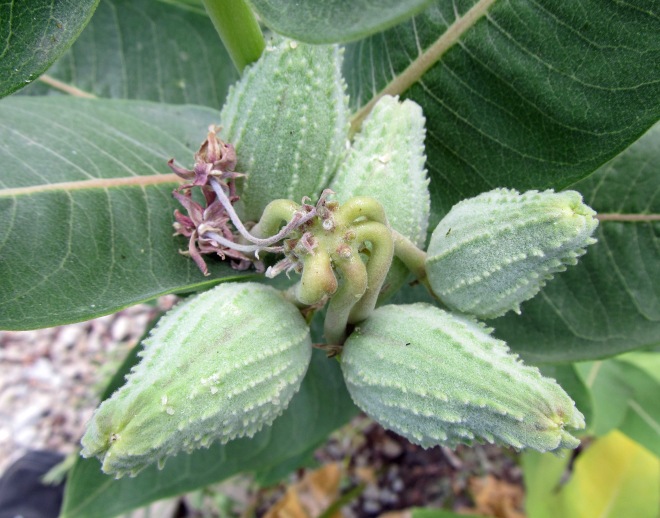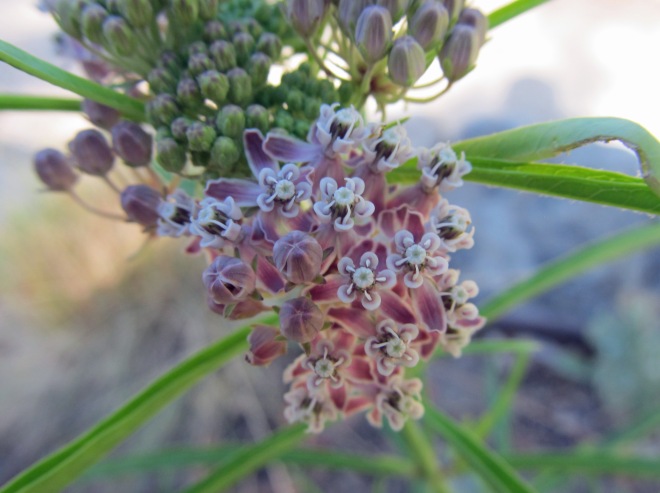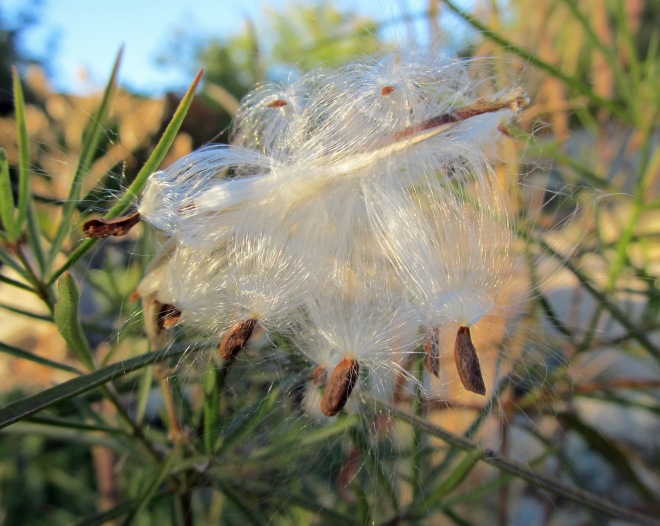An updated version of this post was posted on August 14, 2019. See it here.
———————-
Concern for monarch butterflies has resulted in increasing interest in milkweeds. Understandably so, as they are the host plants and food source for the larval stage of these migrating butterflies. But milkweeds are an impressive group of plants in their own right, and their ecological role extends far beyond a single charismatic insect. Work to save the monarch butterfly, which requires the expansion of milkweed populations, will in turn provide habitat for countless other organisms. A patch of milkweed teems with life, and the pursuit of a single caterpillar helps us discover and explore that.
Asclepias – also known as the milkweeds – is a genus consisting of around 140 species, 72 of which are native to the United States and Canada. Alaska and Hawaii are the only states in the United States that don’t have a native species of milkweed. The ranges of some species native to the United States extend down into Mexico where there are numerous other milkweed species. Central America and South America are also home to many distinct milkweed species.
The habitats milkweeds occupy are about as diverse as the genus itself – from wetlands to prairies, from deserts to forests, and practically anywhere in between. Some species occupy disturbed and/or neglected sites like roadsides, agricultural fields, and vacant lots. For this reason they are frequently viewed as a weed; however, such populations are easily managed, and with such an important ecological role to play, they don’t deserve to be vilified in this way.
Milkweed species are not distributed across the United States evenly. Texas and Arizona are home to the highest diversity with 37 and 29 species respectively. Idaho, my home state, is on the low end with six native species, most of which are relatively rare. The most common species found in Idaho is Asclepias speciosa commonly known as showy milkweed.
Showy milkweed is distributed from central U.S. westward and can be found in all western states. It occurs throughout Idaho and is easily the best place to look for monarch caterpillars. Side note: the monarch butterfly is Idaho’s state insect, thanks in part to the abundance of showy milkweed. This species is frequently found growing in large colonies due to its ability to reproduce vegetatively via adventitious shoots produced on lateral roots or underground stems. Only a handful of milkweed species reproduce this way. Showy milkweed reaches up to five feet tall and has large ovate, gray-green leaves. Like all milkweed species except one (Asclepias tuberosa), its stems and leaves contain milky, latex sap. In early summer, the stems are topped with large umbrella-shaped inflorescences composed of pale pink to pink-purple flowers.
The flowers of milkweed deserve a close examination. Right away you will notice unique features not seen on most other flowers. The petals of milkweed flowers bend backwards, allowing easy access to the flower’s sex parts if it wasn’t for a series of hoods and horns protecting them. Collectively, these hoods and horns are called the corona, which houses glands that produce abundant nectar and has a series of slits where the anthers are exposed. The pollen grains of milkweed are contained in waxy sacs called pollinia. Two pollinia are connected together by a corpusculum giving this structure a wishbone appearance. An insect visiting the flower for nectar slips its leg into the slit, and the pollen sacs become attached with the help of the corpusculum. When the insect leaves, the pollen sacs follow where they can be inadvertently deposited on the stigmas of another flower.
Milkweed flowers are not self-fertile, so they require assistance by insects to sexually reproduce. They are not picky about who does it either, and their profuse nectar draws in all kinds of insects including bees, butterflies, moths, beetles, wasps, and ants. Certain insects – like bumble bees and other large bees – are more efficient pollinators than others. Once pollinated, seeds are formed inside a pod-like fruit called a follicle. The follicles of showy milkweed can be around 5 inches long and house dozens to hundreds of seeds. When the follicle matures, it splits open to release the seeds, which are small, brown, papery disks with a tuft of soft, white, silky hair attached. The seeds of showy milkweed go airborne in late summer.
Whorled or narrowleaf milkweed (Asclepias fascicularis) is widespread in western Idaho and neighboring states. It is adapted to dry locations, but can be found in a variety of habitats. Like showy milkweed, it spreads rhizomatously as well as by seed. Its a whispy plant that can get as tall as four feet. It has long, narrow leaves and produces tight clusters of greenish-white to pink-purple flowers. Its seed pods are long and slender and its seeds are about 1/4 inch long.
Swamp or rose milkweed (Asclepias incarnata) is more common east of Idaho, but occurs occasionally in southwestern Idaho. As its common names suggests, it prefers moist soils and is found in wetlands, wet meadows, and along streambanks. It can spread rhizomatously, but generally doesn’t spread very far. It reaches up to four feet tall, has deep green, lance-shaped leaves, and produces attractive, fragrant, pink to mauve, dome-shaped inflorescenses at the tops of its stems. Its seed pods are narrow and around 3 inches long.
Asclepias cryptoceras, or pallid milkweed, is a low-growing, drought-adapted, diminutive species that occurs in southwestern Idaho. It can be found in the Owyhee mountain range as well as in the Boise Foothills. It has round or oval-shaped leaves and produces flowers on a short stalk. The flowers have white or cream-colored petals and pink-purple hoods.
The two remaining species are fairly rare in Idaho. Antelope horns (Asclepias asperula) is found in Franklin County located in southeastern Idaho. It grows up to two feet tall with an upright or sprawling habit and produces clusters of white to green-yellow flowers with maroon highlights. Horsetail milkweed (Asclepias subverticillata) occurs in at least two counties in central to southeastern Idaho and is similar in appearance to A. fascicularis. Its white flowers help to distinguish between the two. Additional common names for this plant include western whorled milkweed and poison milkweed.







I’d really like to try growing some asclepias viridis, but I haven’t been able to locate a source for the plants, and I’ve planted seeds twice without any success. I think it’s a cool-looking plant, though! I know it’s not native to here, but I think it would do well if I could ever get it started, and I think it would be pretty easy to control as a garden plant.
Pingback: When Milkweed Kills – awkward botany
Nice account of your native Asclepias species! Same comment as on your later post, though: the pollinia are not sticky, they attach mechanically. In addition, the genus Asclepias is also found in southern Africa, though there is some debate over whether these are “true” Asclepias or should be in other genera. The jury’s still out on that.
Thanks again for the correction. A silly oversight on my part. The post has been edited to correct my mistake. I appreciate the help.
Pingback: Episode 21: Monarch Butterflies and Idaho Native Milkweeds – Boise Biophilia
Pingback: Idaho’s Native Milkweeds (Updated) – awkward botany
Thanks for a great article! I’m new to Idaho, and noticed some milkweed but it doesn’t look exactly like the milkweed I’m used to (common milkweed). Seeing your pics, I’m quite sure it’s showy milkweed.